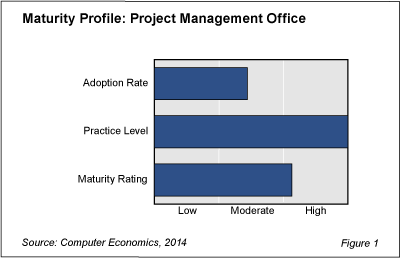The use of project management offices appears to have reached a level of maturity where they have become well entrenched in many larger organizations but the practice no longer appears to be expanding into smaller organizations.
In an effort to improve project success, many companies establish a formal project management office (PMO) as a center of excellence for project management disciplines. In some organizations, the PMO operates as an advisory group to project managers who report directly to business units. In other organizations, project managers report directly to the PMO and are assigned to projects on a case-by-case basis.
Whatever the structure, the establishment of PMOs has become widely embraced practice among large organizations in North America, but less so among smaller organizations. Our study, Project Management Office Adoption Trends, gives the use of PMOs an overall moderate adoption rating when compared with the adoption of 29 other IT management practices in our survey, as shown in Figure 1.

The practice level, however, gets a high rating. In fact, it is at the highest level of any practice in the study. While not every project requires the oversight of the PMO, organizations that establish PMOs tend to make frequent and consistent use of the support, systems, and processes they provide.
The maturity of this practice also earns a high rating, largely because the practice level is so strong. The maturity rating is based on a combination of the adoption rate and practice level. At the same time, the percentage of organizations embracing this practice has remained flat over the past three years.
One of the advantages of having the PMO as a distinct group is that it provides focus. The PMO provides an environment where IT professionals who show promise as project managers are trained in the principles and techniques of project management. The PMO also selects project management tools such as project planning and scheduling systems so that they are available for rapid deployment when new projects are launched.
The full study examines the extent to which IT organizations have deployed PMOs and measures the level of engagement in the practice. We also look at how adoption of this IT management best practice differs by organization size and sector. In addition, the study provides recommendations for monitoring the success of the PMO.
This Research Byte is a brief overview of our report on this subject, Project Management Office Adoption Trends. The full report is available at no charge for Computer Economics clients, or it may be purchased by non-clients directly from our website (click for pricing).

